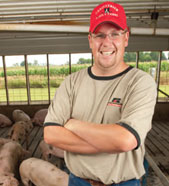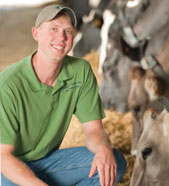
“I have heard the term biosecurity used, what does it mean?”
Biosecurity isn’t a new concept. It’s been in practice for centuries, ever since the first farmer separated a sick animal from the rest of the herd. Today our knowledge of disease transmission has led to a series of thorough, painstaking practices designed to improve animal health and ensure food safety. These include special techniques for handling manure, disinfection, feed storage, boot cleaning, facility maintenance and much more. The bottom line is that farmers are on the leading edge of this knowledge, and are implementing it for the benefit of consumers everywhere.
“Are there food safety requirements for
dairy farmers?”
According to the National Dairy Organization, American dairy products are among the most highly regulated in the world. In addition to the stringent requirements that govern milk production and hauling, pasteurization, product safety, equipment sanitation and labeling, milk is sampled and tested by state regulatory authorities. The FDA and EPA also monitor compliance with these requirements. As Klark Telleen points out, all this is done to meet your expectations.
“Are food-borne illnesses limited to large, conventional farms?”
Far from it. Organic peanut butter was recalled a couple years ago; so was California organic spinach in 2006. Then, there was the raw milk rash of illnesses in Indiana and Michigan. All methods of farming regardless of their size are susceptible to food-borne illnesses if the proper steps aren’t taken. Proper food handling, from the farm to the family table, is a must.
“How safe is the food we produce in this country?”
The U.S. food safety system can always be improved, but it is considered the gold standard by most nations. Our food is as safe, or safer, than any country of equal scale in the world.
Actually, food-borne illness rates are the lowest they’ve been since the Centers for Disease Control (CDC) started collecting that data in 1995. Between 2000 and 2008, the number of people getting sick from E. coli was down by 44%. And the prevalence of E. coli STEC 0157 (the most dangerous strain) showing up in ground beef over the last nine years is down 59%. A recent report from the CDC says, “The recent decrease in STEC 0157 might reflect, in part, control efforts in ground beef processing and produce growing practices.” This doesn’t mean we become complacent, however, but consumers need to understand that we live in a country that has far more stringent regulations than others.
“Is the use of antibiotics in livestock causing us to develop antibiotic resistance diseases such as Methicillin-Resistant Staph Aureus (MRSA)? Should we ban the use of antibiotics in livestock?
According to Dr. Scott Hurd, Iowa State University Associate Professor and Former Deputy Undersecretary Food Safety, USDA, strategic use of antibiotics in animal agriculture prevents disease and produces safer food.
The types of antibiotics used in modern pork production, for example, are not associated with the development of MRSA. Methicillin has never been used in animals in the United States. The human cases of MRSA we see today are typically referred to as community-acquired forms and are often linked to shared areas, such as locker rooms, hospitals, college dorms, etc.—not the meat on your table.
Despite the unsubstantiated allegations surrounding the use of antibiotics in livestock, no conclusive scientific studies have been offered demonstrating the use of antibiotics on farms contributes significantly to an increase in human resistance. In fact, a growing body of evidence shows just the opposite, namely the responsible, professional use of these products reduces pathogens in and on foods, enhancing animal welfare while not contributing to resistance.
Since antibiotics have been used in humans for more than 60 years and in livestock for about 50 years, if there was going to be an epidemic of resistance related to antibiotic use in agriculture it would have occurred by now. The fact that it has not means that antibiotic use in animals is not a major risk to human health.

Dr. Lisa Veach, Infectious Disease Specialist - Iowa Health of Des Moines, says the superbug “MRSA” that is resistant to most antibiotics is a people bug, not something you can get from eating meat from livestock raised with antibiotics. Learn More

Randy Christensen
Hog Farmer
Greene County, Iowa
Some call it biosecurity; Randy Christensen calls it good common sense. By “it” we mean Randy’s practice of showering before entering and after exiting his hog buildings—and requiring visitors to do the same. “By keeping my pigs inside, I can control their climate and keep their environment as clean, comfortable and germ-free as possible. Animal health is a top priority for me. Frequent showering helps keep outside germs away from my pigs, so it just makes sense.”

Klark Telleen
Dairy Farmer
Jones County, Iowa
As a young dairy farmer, Klark is following in his father’s footsteps—and he wouldn’t have it any other way. “It’s important to me to carry on the proud tradition and same great quality as my dad,” he says. “Consumers have every right to count on safe, pure, nutritious milk, and I’m proud that our industry follows stringent standards to meet those expectations. I’m definitely in the right profession.”
“I think the safety of the food supply is really excellent. We do have good safety assurance programs in place.”
—Robert Gravani, PhD, Professor of Food Science, Cornell University
“The safety of food in the United States is better than any other place in the world. We have the most stringent regulations...”
—Roger Clemens, DrPH, Professor, School of Pharmacy, University of Southern California




 choose 2 know your food
choose 2 know your food

